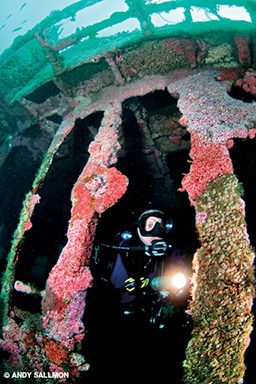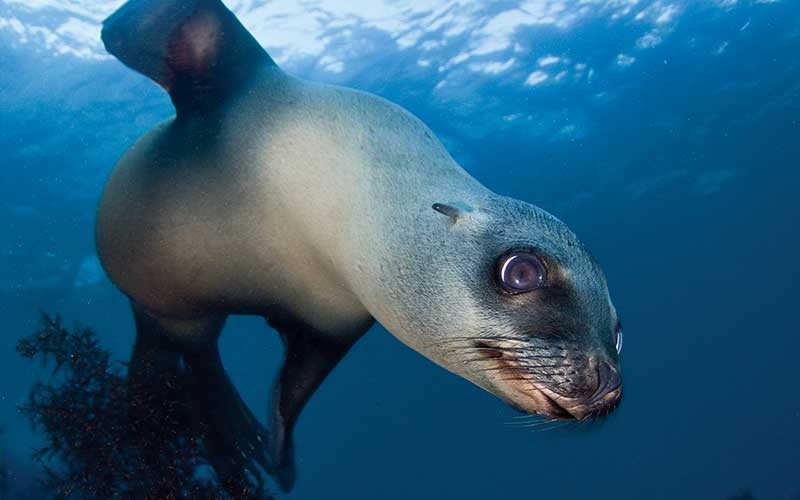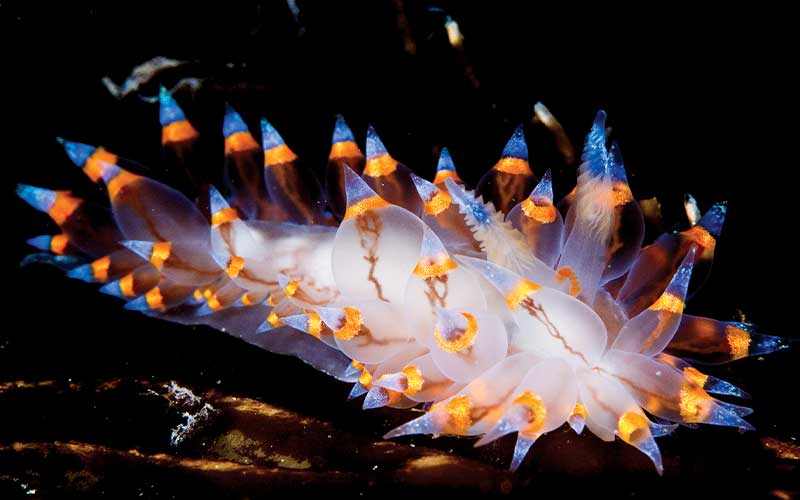I follow the mooring line toward the remains of the HMCS Yukon, a 366-foot Canadian destroyer scuttled 1.8 miles off Mission Beach, a beach community in San Diego, Calif. As I descend with my three dive buddies, we pass the thermocline and feel the temperature drop to 55°F. As we approach a depth of 65 feet, the ship’s tower and gun barrels appear out of a blue-green haze. I aim my light at the ship’s exterior and illuminate a carpet of nickel-sized, orange and pink colonial anthozoans (Corynactis californica), the material that blankets much of the rocks, reefs and wrecks around California. I glide over the tilted deck and approach the starboard side, where Hummer-sized holes have been cut through the steel hull to allow easy access to tank-toting divers.
Exploring the interior of the Yukon can be disorienting as the ship tilts almost 45° to its port side, and walls can appear like ceilings. We venture in and explore large interiors, narrow passageways and even an old restroom replete with urinals. We make our way out and continue around the periphery to the sand at 100 feet, then work our way up past large gun turrets and towers laced with fluffy white Metridium giganteum anemones that sway with the mild current, a stark contrast to the cold steel to which they cling. Since its sinking in 2000, the Yukon has become the living reef it was designed to be. As we make our slow ascent, every inch of the Yukon appears alive. A school of petite blacksmith (Chromis punctipinnis) hovers above the steely bulwark. We spot painted greenlings, California scorpionfish and cabezon nestled in the nooks and crannies before we return through the blue-green haze to the surface.

Of course the Yukon is only one of the many reasons to dive in San Diego. Though the Canadian destroyer is the crown jewel of San Diego’s Wreck Alley, divers can enjoy other unique diving experiences on the Ruby E, a 165-foot Coast Guard cutter; the El Rey, a 100-foot kelp harvester; and the Naval Ocean Systems Center (NOSC) Tower. There are also dozens of dive sites in the well-preserved kelp forests and reefs off Point Loma and in the La Jolla Underwater Park Ecological Reserve (which includes parts of both La Jolla Cove and La Jolla Shores). Only 16 miles due south of San Diego Bay you’ll find yourself circling Mexico’s Los Coronados Islands, home of some of the area’s best visibility and sea life.
La Jolla Shores is San Diego’s easiest shore dive; it features the county’s spot for “muck diving” and the flatlands that border La Jolla Canyon, a trench that drops quickly to 2,000 feet. Whether a photographer or a diver just looking around, the area is great for macro critters and sightings of large halibut, guitarfish and timid leopard sharks — a gray whale was even spotted in 2007. A mere 250 yards to the northwest off the Vallecitos Street entry point, a descent to 45 feet can reveal the small animals that inhabit a muddy 3- to 4-foot wall near the rim of the deep canyon. There a diver might find comical-looking blennies with their oval-mouthed smiles, yellow sprouting with bizarre sprouting eyebrows, two-spot octopi, sheep crab and a plethora of nudibranchs. The area is a macro photographer’s dream, except for the fact that one misplaced kick can churn the vast sand plains and reduce visibility to nil.
Twenty miles down the coast extends the long finger peninsula of Point Loma, home to some of the area’s most consistent kelp and reef diving. A narrow staircase at the end of Sunset Cliffs Boulevard allows access to a rocky entry for a tough (but doable) shore dive, but boat diving is the preferred way to go. Currents are mild, and the reefs are at a comfortable depth of 35 to 65 feet, allowing for satisfying bottom times. The topography is loaded with rock outcroppings, pinnacles and shelves, and the area’s renowned kelp forests are home to a vast array of marine life. Drop below the canopy on a sunny day and watch golden beams of light illuminate the redwood forests of the seas. Circle one of the many seamounts and watch sheephead, kelp bass and garibaldi search for food. Among the rocks nestle sea stars, sunflower stars, Spanish shawls and California spiny lobster.

Sixteen miles due south off Point Loma’s tip lie Mexico’s Los Coronados Islands, what locals call “the Coronados,” a group of four small islands located off Tijuana. The area features two main dive areas on the North Island: the sea lion rookery near the north end, and the “keyhole,” named for a good-sized hole cut through the island. At the rookery, sea lions (Zalophus californianus) often rush out to meet the dive boats and will play with the divers until they get bored and return to their rocky shoreline perches to sun and nap. Harbor seals (Phoca vitulina) are more cautious, but pups get playful at times, even sneaking up and occasionally nibbling divers’ fins. At the south end of North Island is the keyhole; at high tide on a calm day, divers can swim through before circumnavigating the southern tip.
Between North and South Island are two small islands: Pilón de Azúcar (Pile of Sugar) and Central Coronado. These islands are often referred to as the “Middle Grounds,” an area abundant with invertebrate life and fish. Middle Grounds has none of the giant kelp the other islands have, yet it boasts a stark beauty all its own. Several underwater ridges emanate from the island, reaching seaward like spokes from a hub to depths of 60 and 80 feet with sand and rubble strewn between. The ridge tops reach shallower depths around 40 feet, so multilevel dives can be enjoyed. Along the rocky ridges and occasional pinnacles, divers can find large sheep crab foraging for a meal along with stingrays, bat rays and flatfish such as halibut and sole. On the ridges themselves, golden and red gorgonian sea fans dot the tops and sides of the strata. Undercuts in the rocks and pinnacles create great hideouts for nudibranchs and other invertebrates, while rockfish, snubnose sculpin and California scorpionfish lay in wait to ambush unwary hermit crabs. Riding the currents sweeping in from the open sea, pelagic jellyfish drift by.

At the southernmost part of the Coronados is the South Kelp Beds. This area, a mile below South Island, is rich with life but inaccessible much of the time due to its location in the open sea. The underwater terrain is relatively flat, varying from 40 to 80 feet, but then drops deeper beyond the kelp itself. Boasting some of the area’s richest and clearest kelp diving, large schools of blacksmith, opaleye and halfmoon feed on plankton near the canopy on the northeast edge. It is not uncommon to find 500-pound giant sea bass hovering motionless in the shadows near the base of the kelp. A tiered terrace of rock, cracks and shelves provides hideouts for small fish and invertebrates, while several species of nudibranchs forage on the large grey “ooze” sponge. Multitentacled sunflower stars the size of hubcaps move almost imperceptibly in hopes of catching a weary hermit crab for dinner. Sheep crab hide among the kelp holdfasts to elude intruders as they wait for a fish to expire or for scraps to fall from other foragers. Life is vibrant and illuminated with a constant glow of gold from the kelp above, a world away from the towering high rises and frenetic scene of San Diego’s downtown — 20 miles and another country away.
How To Dive It

Conditions: Average water temperatures range from 56°F in winter to 70°F in summer, though temperatures can drop 5-10°F at depth. Visibility depends on the dive site: Average visibility for shore and wreck dives can be anywhere from 15 to 40 feet, while visibility at the Coronado Islands can range from 40 to 70-plus feet. Dives around the middle islands are open ocean, so good planning and surface signaling devices are strongly recommended.
For daily weather and ocean conditions, dial +1-619-221-8824 for a recording from the City of San Diego Lifeguards.
Getting There: Flights to San Diego International Airport (Lindbergh Field) (SAN) land within 2 miles of the city’s bay front downtown. Rent a car and find lodging based on your interests and budget — every place mentioned in this article is within a 20-minute drive of downtown. Downtown San Diego is 120 miles south of Los Angeles, Calif., and 15 miles north of Tijuana, Mexico (take Interstate 5 from either place).
On the Surface
With 70 miles of coastline, a world-famous zoo surrounded by museums and theaters in an urban park larger than Central Park, and epic nightlife in the beautiful Gaslamp Quarter, San Diego has plenty of topside activities to satisfy a broad range of tastes. My top pick for the adventurous: paragliding over La Jolla’s beaches from the Torrey Pines Gliderport — get a different perspective of your dive sites while enjoying the thrill of flying over the ocean and sandstone cliffs, with views of Scripps Pier, La Jolla Underwater Park Ecological Reserve and the San Diego Marine Life Refuge. Try surfing at legendary La Jolla Shores, or try the also-popular kayaking and stand-up paddling. Most kayak rental shops offer snorkeling gear as well. The Birch Aquarium at Scripps is nearby, and there are plenty of good restaurants and cafes nestled above La Jolla Cove and at the Shores.
© Alert Diver — Q1 Winter 2011